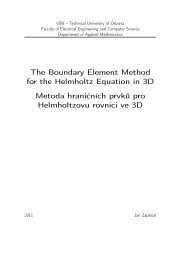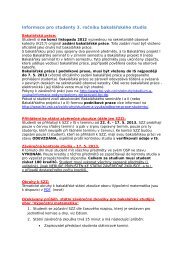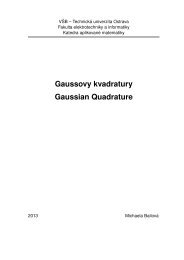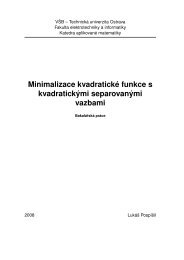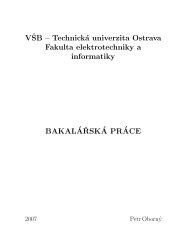Lyapunov exponents of the predator prey model Ljapunovovy ...
Lyapunov exponents of the predator prey model Ljapunovovy ...
Lyapunov exponents of the predator prey model Ljapunovovy ...
You also want an ePaper? Increase the reach of your titles
YUMPU automatically turns print PDFs into web optimized ePapers that Google loves.
173 <strong>Lyapunov</strong> <strong>exponents</strong> for one-dimensional mapsIn this section <strong>Lyapunov</strong> <strong>exponents</strong> are computed for one-dimensional maps. We introducea numerical approximation <strong>of</strong> <strong>Lyapunov</strong> exponent and compute <strong>Lyapunov</strong> <strong>exponents</strong><strong>of</strong> well-known maps such as Tent map or Logistic map. Here we show also what<strong>the</strong> <strong>Lyapunov</strong> exponent describes and how it depends on <strong>the</strong> behavior <strong>of</strong> <strong>the</strong> dynamicalsystem.Definition 3.1 Let X = [a, b] , a, b ∈ R be an interval, µ is an absolutely continuous invariantmeasure on that interval and f is a piecewise continuously differentiable map on X. The numberis called <strong>the</strong> <strong>Lyapunov</strong> exponent <strong>of</strong> f.L (f) = balog f ′ dµThe alternative definition <strong>of</strong> <strong>Lyapunov</strong> exponent isn−11 L (f) = lim log f ′ f k (x)a.e.n→∞ nk=0which can be obtained from Definition 3.1 by using <strong>the</strong> Birkh<strong>of</strong>f Ergodic Theorem (Theorem2.22). This definition is <strong>of</strong>ten used since computing <strong>the</strong> integral in <strong>the</strong> Definition 3.1can be hard.The <strong>Lyapunov</strong> exponent is <strong>of</strong>ten used for indication <strong>of</strong> sensitive dependence on initialconditions. The system with negative <strong>Lyapunov</strong> exponent is considered stable and <strong>the</strong>system with positive <strong>Lyapunov</strong> exponent is considered unstable or chaotic. This isn’t truefor general maps. In [18] was proved that positive <strong>Lyapunov</strong> exponent implies sensitivedependence on initial conditions under some additional conditions for continuous mapson <strong>the</strong> closed interval (see Proposition 3.3). Moreover in [18] it was shown that <strong>the</strong> map is<strong>Lyapunov</strong> stable if <strong>the</strong> <strong>Lyapunov</strong> exponent is negative taking into account continuouslydifferentiable maps on <strong>the</strong> closed interval (see Proposition 3.2).Proposition 3.2 Suppose f : [0, 1] → [0, 1] is C 2 . If <strong>the</strong> <strong>Lyapunov</strong> exponent L (f) < 0 forsome x 0 , <strong>the</strong>n <strong>the</strong> orbit <strong>of</strong> x 0 is <strong>Lyapunov</strong> stable.Proposition 3.3 Suppose f : [0, 1] → [0, 1] is C 2 . If <strong>the</strong> <strong>Lyapunov</strong> exponent L (f) > 0 forsome x 0 and <strong>the</strong> orbit <strong>of</strong> x 0 satisfiesinf f ′ (x n ) > 0,n≥0<strong>the</strong>n <strong>the</strong> orbit exhibits sensitive dependence on initial conditions.Open question 3.4 (i) If a continuous map on interval has positive <strong>Lyapunov</strong> exponent,does it imply chaos? If it does, in which sense?



